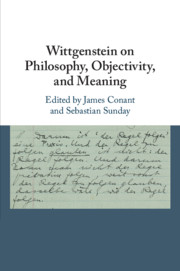Book contents
- Wittgenstein on Philosophy, Objectivity, and Meaning
- Wittgenstein on Philosophy, Objectivity, and Meaning
- Copyright page
- Contents
- Contributors
- Preface
- Acknowledgments
- Chapter 1 Anatomy of a Muddle: Wittgenstein and Philosophy
- Chapter 2 Explaining What We Mean
- Chapter 3 Objectivity
- Chapter 4 The Methodological Significance of Intuitions in Philosophy
- Chapter 5 Wittgenstein on ‘Seeing Meanings’
- Chapter 6 Bringing the Phenomenal World into View
- Chapter 7 First Steps and Conceptual Creativity
- Chapter 8 Wittgenstein and Analytic Revisionism
- Chapter 9 Demystifying Meaning in Horwich and Wittgenstein
- Chapter 10 What Is Meaning? A Wittgensteinian Answer to an Un-Wittgensteinian Question
- Chapter 11 Meaning, Use, and Supervenience
- Chapter 12 Some Socratic Aspects of Wittgenstein’s Conception of Philosophy
- References
- Index
Chapter 5 - Wittgenstein on ‘Seeing Meanings’
Published online by Cambridge University Press: 15 August 2019
- Wittgenstein on Philosophy, Objectivity, and Meaning
- Wittgenstein on Philosophy, Objectivity, and Meaning
- Copyright page
- Contents
- Contributors
- Preface
- Acknowledgments
- Chapter 1 Anatomy of a Muddle: Wittgenstein and Philosophy
- Chapter 2 Explaining What We Mean
- Chapter 3 Objectivity
- Chapter 4 The Methodological Significance of Intuitions in Philosophy
- Chapter 5 Wittgenstein on ‘Seeing Meanings’
- Chapter 6 Bringing the Phenomenal World into View
- Chapter 7 First Steps and Conceptual Creativity
- Chapter 8 Wittgenstein and Analytic Revisionism
- Chapter 9 Demystifying Meaning in Horwich and Wittgenstein
- Chapter 10 What Is Meaning? A Wittgensteinian Answer to an Un-Wittgensteinian Question
- Chapter 11 Meaning, Use, and Supervenience
- Chapter 12 Some Socratic Aspects of Wittgenstein’s Conception of Philosophy
- References
- Index
Summary
This essay contextualises Wittgenstein’s remarks on aspect-seeing in connection with his reading of Wolfgang Köhler, and thereby within a wider discussion of seeing. Most commentators devote little attention to the use of ‘see’ with which aspect-seeing is contrasted. It tends to be interpreted in the literature in two contrasting ways which, the author suggests, could be lined up with Köhler’s distinction between ‘analytic’ and ‘normal’ modes of perception, corresponding to a distinction between ‘seeing shapes and colours’ and ‘seeing things’. It is argued that Wittgenstein’s ‘aspect-seeing’ use of ‘see’ contrasts differently with each of these. Moreover, it is argued that these three uses of ‘see’ work differently in the context of looking at pictures and looking at the world. Finally, it is suggested that understanding Wittgenstein’s claim that seeing an aspect is ‘seeing a meaning’ is an invitation to contemplate what would be missing from the life of the aspect-blind; and it is suggested that seeing a thingis likewise ‘seeing a meaning’.
Keywords
- Type
- Chapter
- Information
- Wittgenstein on Philosophy, Objectivity, and Meaning , pp. 84 - 99Publisher: Cambridge University PressPrint publication year: 2019

